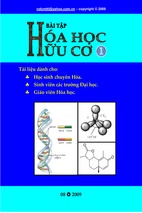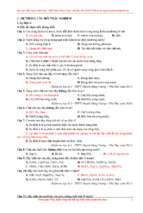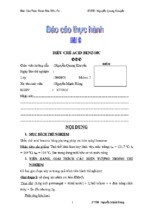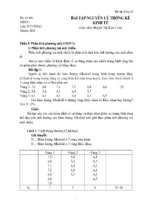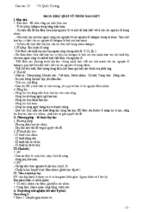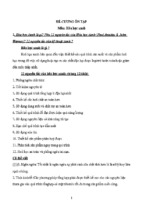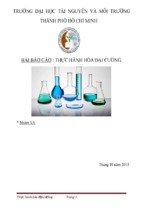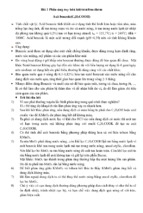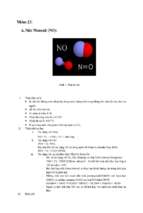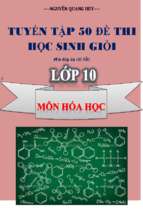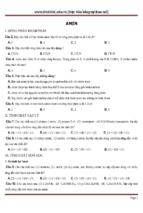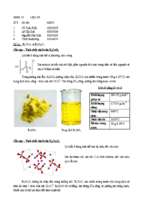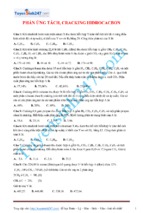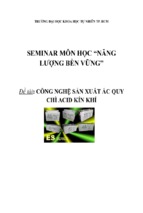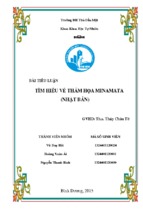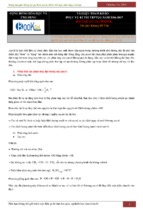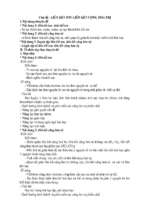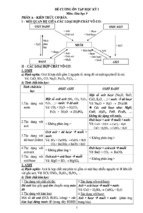Biochemistry for Dummies - John T. Moore, Richard H. Langley
01_194287 ffirs.qxp
3/27/08
12:30 AM
Page i
Biochemistry
FOR
DUMmIES
by John T. Moore, EdD and
Richard Langley, PhD
‰
01_194287 ffirs.qxp
3/27/08
12:30 AM
Page iv
01_194287 ffirs.qxp
3/27/08
12:30 AM
Page i
Biochemistry
FOR
DUMmIES
by John T. Moore, EdD and
Richard Langley, PhD
‰
01_194287 ffirs.qxp
3/27/08
12:30 AM
Page ii
Biochemistry For Dummies®
Published by
Wiley Publishing, Inc.
111 River St.
Hoboken, NJ 07030-5774
www.wiley.com
Copyright © 2008 by Wiley Publishing, Inc., Indianapolis, Indiana
Published by Wiley Publishing, Inc., Indianapolis, Indiana
Published simultaneously in Canada
No part of this publication may be reproduced, stored in a retrieval system, or transmitted in any form or
by any means, electronic, mechanical, photocopying, recording, scanning, or otherwise, except as permitted under Sections 107 or 108 of the 1976 United States Copyright Act, without either the prior written
permission of the Publisher, or authorization through payment of the appropriate per-copy fee to the
Copyright Clearance Center, 222 Rosewood Drive, Danvers, MA 01923, 978-750-8400, fax 978-646-8600.
Requests to the Publisher for permission should be addressed to the Legal Department, Wiley Publishing,
Inc., 10475 Crosspoint Blvd., Indianapolis, IN 46256, 317-572-3447, fax 317-572-4355, or online at http://
www.wiley.com/go/permissions.
Trademarks: Wiley, the Wiley Publishing logo, For Dummies, the Dummies Man logo, A Reference for the
Rest of Us!, The Dummies Way, Dummies Daily, The Fun and Easy Way, Dummies.com and related trade
dress are trademarks or registered trademarks of John Wiley & Sons, Inc. and/or its affiliates in the United
States and other countries, and may not be used without written permission. All other trademarks are the
property of their respective owners. Wiley Publishing, Inc., is not associated with any product or vendor
mentioned in this book.
LIMIT OF LIABILITY/DISCLAIMER OF WARRANTY: THE PUBLISHER AND THE AUTHOR MAKE NO REPRESENTATIONS OR WARRANTIES WITH RESPECT TO THE ACCURACY OR COMPLETENESS OF THE CONTENTS OF THIS WORK AND SPECIFICALLY DISCLAIM ALL WARRANTIES, INCLUDING WITHOUT
LIMITATION WARRANTIES OF FITNESS FOR A PARTICULAR PURPOSE. NO WARRANTY MAY BE CREATED OR EXTENDED BY SALES OR PROMOTIONAL MATERIALS. THE ADVICE AND STRATEGIES CONTAINED HEREIN MAY NOT BE SUITABLE FOR EVERY SITUATION. THIS WORK IS SOLD WITH THE
UNDERSTANDING THAT THE PUBLISHER IS NOT ENGAGED IN RENDERING LEGAL, ACCOUNTING, OR
OTHER PROFESSIONAL SERVICES. IF PROFESSIONAL ASSISTANCE IS REQUIRED, THE SERVICES OF A
COMPETENT PROFESSIONAL PERSON SHOULD BE SOUGHT. NEITHER THE PUBLISHER NOR THE
AUTHOR SHALL BE LIABLE FOR DAMAGES ARISING HEREFROM. THE FACT THAT AN ORGANIZATION
OR WEBSITE IS REFERRED TO IN THIS WORK AS A CITATION AND/OR A POTENTIAL SOURCE OF FURTHER INFORMATION DOES NOT MEAN THAT THE AUTHOR OR THE PUBLISHER ENDORSES THE INFORMATION THE ORGANIZATION OR WEBSITE MAY PROVIDE OR RECOMMENDATIONS IT MAY MAKE.
FURTHER, READERS SHOULD BE AWARE THAT INTERNET WEBSITES LISTED IN THIS WORK MAY HAVE
CHANGED OR DISAPPEARED BETWEEN WHEN THIS WORK WAS WRITTEN AND WHEN IT IS READ.
For general information on our other products and services, please contact our Customer Care
Department within the U.S. at 800-762-2974, outside the U.S. at 317-572-3993, or fax 317-572-4002.
For technical support, please visit www.wiley.com/techsupport.
Wiley also publishes its books in a variety of electronic formats. Some content that appears in print may
not be available in electronic books.
Library of Congress Control Number: 2008923128
ISBN: 978-0-470-19428-7
Manufactured in the United States of America
10 9 8 7 6 5 4 3 2 1
01_194287 ffirs.qxp
3/27/08
12:30 AM
Page iii
About the Authors
John Moore grew up in the foothills of Western North Carolina. He attended
the University of North Carolina at Asheville, where he received his bachelor’s degree in chemistry. He earned his master’s degree in chemistry from
Furman University in Greenville, South Carolina. After a stint in the United
States Army, he decided to try his hand at teaching. In 1971, he joined the
chemistry faculty of Stephen F. Austin State University in Nacogdoches,
Texas, where he still teaches chemistry. In 1985 he started back to school
part time and in 1991 received his doctorate in education from Texas A&M
University. For the last five years has been the co-editor (along with one of
his former students) of the “Chemistry for Kids” feature of The Journal of
Chemical Education. In 2003, his first book, Chemistry For Dummies, was published, soon to be followed by Chemistry Made Simple. John enjoys cooking
and making custom knife handles from exotic woods.
Richard Langley grew up in southwestern Ohio. He attended Miami University
in Oxford, Ohio, where he received bachelor’s degrees in chemistry and mineralogy and then a master’s degree in chemistry. His next stop was the University
of Nebraska, where he received his doctorate in chemistry. Afterwards, he took
a postdoctoral position at Arizona State University in Tempe, Arizona, followed
by a visiting assistant professor position at the University of Wisconsin at River
Falls. In 1982, he moved to Stephen F. Austin State University. For the past several years, he and John have been graders for the Free Response portion of the
AP Chemistry Exam. He and John have collaborated on several writing projects, including 5 Steps To A 5 on the AP: Chemistry and Chemistry for the Utterly
Confused. Rich enjoys jewelry making and science fiction.
01_194287 ffirs.qxp
3/27/08
12:30 AM
Page iv
01_194287 ffirs.qxp
3/27/08
12:30 AM
Page v
Dedication
To my wife, Robin; sons, Matthew and Jason; my wonderful daughter-in-law,
Sara; and the two most wonderful grandkids in the world, Zane and Sadie.
I love you guys. — John
To my mother. — Rich
Authors’ Acknowledgments
We would not have had the opportunity to write this book without the
encouragement of our agent, Grace Freedson. We would also like to thank
Kristin DeMint for her support and assistance in the early portion of this project and to Corbin Collins who helped us complete it. Thanks to our colleague
Michele Harris who helped with suggestions and ideas. And many thanks to
all of the people at Wiley publishing who helped bring this project from concept to publication.
01_194287 ffirs.qxp
3/27/08
12:30 AM
Page vi
Publisher’s Acknowledgments
We’re proud of this book; please send us your comments through our Dummies online registration
form located at www.dummies.com/register/.
Some of the people who helped bring this book to market include the following:
Acquisitions, Editorial, and
Media Development
Composition Services
Project Coordinator: Lynsey Stanford
Project Editors: Kristin DeMint and
Corbin Collins
Layout and Graphics: Carrie A. Cesavice,
Alissa D. Ellet, Stephanie D. Jumper
Acquisitions Editor: Stacy Kennedy
Copy Editors: Josh Dials and Corbin Collins
Proofreaders: Laura Albert, Caitie Kelly,
Toni Settle
Technical Editor: Medhane Cumbay
Indexer: Potomac Indexing, LLC
Project Manager I: Laura Moss-Hollister
Media Development Specialist: Kit Malone
Editorial Manager: Michelle Hacker
Editorial Supervisor and Reprint Editor:
Carmen Krikorian
Art Coordinator: Alicia B. South
Editorial Assistants: David Lutton and
Leeann Harney
Cover Photos: Rox Woodward
Cartoons: Rich Tennant (www.the5thwave.com)
Publishing and Editorial for Consumer Dummies
Diane Graves Steele, Vice President and Publisher, Consumer Dummies
Joyce Pepple, Acquisitions Director, Consumer Dummies
Kristin A. Cocks, Product Development Director, Consumer Dummies
Kathleen Nebenhaus, Vice President and Executive Publisher, Consumer Dummies, Lifestyles,
Pets, Education Publishing for Technology Dummies
Composition Services
Gerry Fahey, Vice President of Production Services
Debbie Stailey, Director of Composition Services
02_194287 ftoc.qxp
3/27/08
12:30 AM
Page vii
Contents at a Glance
Introduction .................................................................1
Part I: Setting the Stage: Basic Biochemistry Concepts ...7
Chapter 1: Biochemistry: What You Need to Know and Why.......................................9
Chapter 2: Dive In: Water Chemistry..............................................................................17
Chapter 3: Fun with Carbon: Organic Chemistry .........................................................33
Part II: The Meat of Biochemistry: Proteins ..................49
Chapter 4: Amino Acids: The Building Blocks of Protein ............................................51
Chapter 5: Protein Structure and Function ...................................................................67
Chapter 6: Enzymes Kinetics: Getting There Faster.....................................................85
Part III: Carbohydrates, Lipids, Nucleic Acids,
and More .................................................................109
Chapter 7: What We Crave: Carbohydrates ................................................................111
Chapter 8: Lipids and Membranes ...............................................................................127
Chapter 9: Nucleic Acids and the Code of Life ...........................................................143
Chapter 10: Vitamins and Nutrients.............................................................................155
Chapter 11: Be Quiet: Hormones ..................................................................................173
Part IV: Bioenergetics and Pathways .........................183
Chapter 12: Life and Energy ..........................................................................................185
Chapter 13: ATP: The Body’s Monetary System .........................................................195
Chapter 14: Smelly Biochemistry: Nitrogen in Biological Systems..........................235
Part V: Genetics: Why We Are What We Are...............257
Chapter 15: Photocopying DNA....................................................................................259
Chapter 16: Transcribe This! RNA Transcription.......................................................281
Chapter 17: Translation: Protein Synthesis ................................................................301
Part VI: The Part of Tens ...........................................315
Chapter 18: Ten Great Applications of Biochemistry ................................................317
Chapter 19: Ten Biochemistry Careers........................................................................321
Index .......................................................................325
02_194287 ftoc.qxp
3/27/08
12:30 AM
Page viii
02_194287 ftoc.qxp
3/27/08
12:30 AM
Page ix
Table of Contents
Introduction..................................................................1
About This Book...............................................................................................1
Conventions Used in This Book .....................................................................2
Icons Used in This Book..................................................................................2
What You’re Not to Read.................................................................................3
Foolish Assumptions .......................................................................................3
How This Book Is Organized...........................................................................3
Part I: Setting the Stage: Basic Biochemistry Concepts ....................4
Part II: The Meat of Biochemistry: Proteins........................................4
Part III: Carbohydrates, Lipids, Nucleic Acids, and More .................4
Part IV: Bioenergetics and Pathways ...................................................4
Part V: Genetics: Why We Are What We Are .......................................5
Part VI: The Part of Tens .......................................................................5
Where to Go from Here....................................................................................5
Part I: Setting the Stage: Basic Biochemistry Concepts ....7
Chapter 1: Biochemistry: What You Need to Know and Why . . . . . . . .9
Why Biochemistry?..........................................................................................9
What Is Biochemistry and Where Does It Take Place? ..............................10
Types of Living Cells ......................................................................................10
Prokaryotes...........................................................................................11
Eukaryotes ............................................................................................11
Animal Cells and How They Work ................................................................12
A Brief Look at Plant Cells.............................................................................14
Chapter 2: Dive In: Water Chemistry . . . . . . . . . . . . . . . . . . . . . . . . . . . .17
The Fundamentals of H2O..............................................................................17
Let’s get wet! Physical properties of water .......................................18
Water’s most important biochemical role: The solvent ..................20
Hydrogen Ion Concentration: Acids and Bases..........................................21
Achieving equilibrium..........................................................................22
Sour and bitter numbers: The pH scale.............................................23
Calculating pOH....................................................................................24
Strong and weak: Brønsted-Lowry theory ........................................25
Buffers and pH Control..................................................................................29
Identifying common physiological buffers........................................29
Calculating a buffer’s pH .....................................................................30
02_194287 ftoc.qxp
x
3/27/08
12:30 AM
Page x
Biochemistry For Dummies
Chapter 3: Fun with Carbon: Organic Chemistry . . . . . . . . . . . . . . . . . .33
The Role of Carbon in the Study of Life ......................................................33
It’s All in the Numbers: Carbon Bonds ........................................................34
Sticky Chemistry: Bond Strengths ...............................................................35
Everybody has ‘em: Intermolecular forces .......................................35
Water-related interactions: Both the lovers and the haters ...........36
How bond strengths affect physical properties of substances......37
Defining a Molecule’s Reactivity: Functional Groups ................................38
Hydrocarbons .......................................................................................38
Functional groups with oxygen and sulfur........................................38
Functional groups containing nitrogen .............................................40
Functional groups containing phosphorus.......................................40
Reactions of functional groups...........................................................41
pH and functional groups ....................................................................43
Same Content, Different Structure: Isomerism...........................................44
Cis-trans isomers..................................................................................45
Chiral carbons ......................................................................................45
Part II: The Meat of Biochemistry: Proteins ...................49
Chapter 4: Amino Acids: The Building Blocks of Protein . . . . . . . . . .51
General Properties of Amino Acids .............................................................52
Amino acids are positive and negative: The zwitterion formation....52
Protonated? pH and the isoelectric point .........................................53
Asymmetry: Chiral amino acids .........................................................54
The Magic 20 Amino Acids............................................................................55
Nonpolar (hydrophobic) amino acids ...............................................55
Polar and uncharged (hydrophilic) amino acids .............................57
Acidic amino acids ...............................................................................57
Basic amino acids.................................................................................59
Lest We Forget: Rarer Amino Acids .............................................................59
Rudiments of Amino Acid Interactions .......................................................60
Intermolecular forces: How an amino acid reacts with
other molecules ................................................................................61
Altering interactions by changing an amino acid’s pH....................62
Combining Amino Acids: How It Works.......................................................64
The peptide bond and the dipeptide .................................................64
Tripeptide: adding an amino acid to a dipeptide .............................65
Chapter 5: Protein Structure and Function . . . . . . . . . . . . . . . . . . . . . . .67
Primary Structure: The Structure Level All Proteins Have.......................68
Building a protein: Outlining the process .........................................69
Organizing the amino acids.................................................................69
Example: The primary structure of insulin .......................................70
02_194287 ftoc.qxp
3/27/08
12:30 AM
Page xi
Table of Contents
Secondary Structure: A Structure Level Most Proteins Have ..................71
The α-helix.............................................................................................72
The β-pleated sheet..............................................................................73
β-turns and the Ω-loops .......................................................................74
Tertiary Structure: A Structure Level Many Proteins Have ......................75
Quaternary Structure: A Structure Level Some Proteins Have ................76
Dissecting a Protein for Study ......................................................................76
Separating proteins within a cell and purifying them .....................77
Digging into the details: Uncovering a protein’s amino acid
sequence ............................................................................................79
Chapter 6: Enzymes Kinetics: Getting There Faster . . . . . . . . . . . . . . . .85
Enzyme Classification: The Best Catalyst for the Job ...............................86
Up one, down one: Oxidoreductases .................................................87
You don’t belong here: Transferases .................................................88
Water does it again: Hydrolases .........................................................88
Taking it apart: Lyases .........................................................................89
Shuffling the deck: Isomerases ...........................................................90
Putting it together: Ligases .................................................................90
Enzymes as Catalysts: When Fast Is Not Fast Enough ..............................91
Models of catalysis: Lock and key versus induced-fit .....................91
All About Kinetics ..........................................................................................92
Enzyme assays: Fixed time and kinetic .............................................94
Rate determination: How fast is fast? ...............................................94
Measuring Enzyme Behavior: The Michaelis-Menten Equation...............96
Ideal applications .................................................................................99
Realistic applications.........................................................................101
Here we go again: Lineweaver-Burk plots .......................................101
Enzyme Inhibition: Slowing It Down ..........................................................103
Competititive inhibition ....................................................................104
Noncompetitive inhibition ................................................................104
Graphing inhibition ............................................................................104
Enzyme Regulation.......................................................................................104
Allosteric control................................................................................106
Multiple enzyme forms ......................................................................106
Covalent modification........................................................................106
Proteolytic activation ........................................................................106
Part III: Carbohydrates, Lipids, Nucleic Acids,
and More ..................................................................109
Chapter 7: What We Crave: Carbohydrates . . . . . . . . . . . . . . . . . . . . .111
Properties of Carbohydrates ......................................................................112
They contain one or more chiral carbons ......................................112
They have multiple chiral centers ...................................................113
xi
02_194287 ftoc.qxp
xii
3/27/08
12:30 AM
Page xii
Biochemistry For Dummies
A Sweet Topic: Monosaccharides ..............................................................114
The most stable monosaccharide structures: Pyranose
and furanose forms.........................................................................114
Chemical properties of monosaccharides ......................................117
Derivatives of the monosaccharides ...............................................118
The most common monosaccharides .............................................120
The beginning of life: Ribose and deoxyribose ..............................121
Sugars Joining Hands: Oligosaccharides.........................................121
Keeping it simple: Disaccharides .....................................................122
Starch and cellulose: Polysaccharides ............................................125
Chapter 8: Lipids and Membranes . . . . . . . . . . . . . . . . . . . . . . . . . . . . .127
Lovely Lipids: An Overview ........................................................................127
A Fatty Subject: Triglycerides ....................................................................130
Properties and structures of fats .....................................................130
Cleaning up: Breaking down a triglyceride .....................................131
No Simpletons Here: Complex Lipids ........................................................132
Phosphoglycerides ............................................................................132
Sphingolipids ......................................................................................134
Sphingophospholipids.......................................................................135
Membranes: The Bipolar and the Bilayer .................................................135
Crossing the wall: Membrane transport..........................................137
Pumps ..................................................................................................137
Channels ..............................................................................................138
Steroids: Pumping up.........................................................................139
Prostaglandins, Thromboxanes, and Leukotrienes: Mopping Up..........140
Chapter 9: Nucleic Acids and the Code of Life . . . . . . . . . . . . . . . . . .143
Nucleotides: The Guts of DNA and RNA....................................................143
Reservoir of genetic info: Nitrogen bases .......................................143
The sweet side of life: The sugars ....................................................146
The sour side of life: Phosphoric acid .............................................146
Tracing the Process: From Nucleoside to Nucleotide to Nucleic Acid...147
First reaction: Nitrogen base + 5-carbon sugar = nucleoside .......147
Second reaction: Phosphoric acid + nucleoside = nucleotide......148
Third reaction: Nucleotide becomes nucleic acid .........................149
A Primer on Nucleic Acids ..........................................................................149
DNA and RNA in the grand scheme of life.......................................151
Nucleic acid structure .......................................................................151
Chapter 10: Vitamins and Nutrients . . . . . . . . . . . . . . . . . . . . . . . . . . . .155
More than One-a-Day: Basics of Vitamins .................................................156
To B or Not to B: B Complex Vitamins.......................................................156
Vitamin B1 (thiamine).........................................................................157
Vitamin B2 (riboflavin) .......................................................................158
Vitamin B3 (niacin)..............................................................................159
Vitamin B6 (pyridoxine) .....................................................................159
02_194287 ftoc.qxp
3/27/08
12:30 AM
Page xiii
Table of Contents
Biotin....................................................................................................162
Folic acid .............................................................................................162
Pantothenic acid.................................................................................163
The wonders of vitamin B12 ...............................................................164
Vitamin A.......................................................................................................165
Vitamin D.......................................................................................................166
Vitamin E .......................................................................................................169
Vitamin K.......................................................................................................169
Vitamin C .......................................................................................................170
Chapter 11: Be Quiet: Hormones . . . . . . . . . . . . . . . . . . . . . . . . . . . . . . .173
Structures of Some Key Hormones ............................................................173
Proteins................................................................................................174
Steroids................................................................................................174
Amines .................................................................................................176
Before and After: Prohormones .................................................................178
Proinsulin ............................................................................................178
Angiotensinogen.................................................................................178
Fight or Flight: Hormone Function.............................................................179
Opening the letter: Hormonal action ...............................................179
Models of hormonal action ..............................................................181
Part IV: Bioenergetics and Pathways ..........................183
Chapter 12: Life and Energy . . . . . . . . . . . . . . . . . . . . . . . . . . . . . . . . . . .185
ATP: The Energy Pony Express...................................................................185
ATP and free energy ...........................................................................186
ATP as an energy transporter ...........................................................187
It’s Relative: Molecules Related to ATP .....................................................190
The nucleoside triphosphate family ................................................190
As easy as 1, 2, 3: AMP, ADP, and ATP ..............................................192
Where It All Comes From ...........................................................................193
Chapter 13: ATP: The Body’s Monetary System . . . . . . . . . . . . . . . . . .195
Metabolism I: Glycolysis .............................................................................195
Glucose: Where it all starts ...............................................................198
Miles per gallon? Energy efficiency..................................................199
Going in reverse: Gluconeogenesis ..................................................199
Alcoholic fermentation: We’ll drink to that.....................................201
Metabolism II: Citric Acid (Krebs) Cycle...................................................202
Let’s get started: Synthesis of acetyl-CoA .......................................205
Three’s a crowd: Tricarboxylic acids...............................................206
Just a little gas: Oxidative decarboxylation ....................................206
Production of succinate and GTP.....................................................207
Oxaloacetate regeneration ................................................................207
Amino acids as energy sources ........................................................208
xiii
02_194287 ftoc.qxp
xiv
3/27/08
12:30 AM
Page xiv
Biochemistry For Dummies
Electron Transport and Oxidative Phosphorylation ...............................210
The electron transport system.........................................................210
The script: Oxidative phosphorylation ...........................................218
The play: Proposed mechanisms .....................................................218
The box office: ATP production........................................................219
Involving the fats: β-oxidation cycle ................................................219
Not so heavenly bodies: Ketone bodies ..........................................221
Investing in the Future: Biosynthesis ........................................................223
Fatty acids ...........................................................................................224
Membrane lipids.................................................................................226
Amino acids.........................................................................................228
Chapter 14: Smelly Biochemistry: Nitrogen in Biological Systems . . .235
Ring in the Nitrogen: Purine........................................................................235
Biosynthesis of purine .......................................................................236
How much will it cost?.......................................................................245
Pyrimidine Synthesis ...................................................................................245
First step: Carbamoyl phosphate .....................................................245
Next step: Orotate ..............................................................................245
Last step: Cytidine..............................................................................248
Back to the Beginning: Catabolism ...........................................................248
Nucleotide catabolism .......................................................................249
Amino acid catabolism ......................................................................249
Heme catabolism ...............................................................................250
Process of Elimination: The Urea Cycle ...................................................250
Amino Acids Once Again.............................................................................254
Metabolic Disorders ....................................................................................255
Gout......................................................................................................255
Lesch-Nyhan syndrome .....................................................................255
Albinism...............................................................................................255
Alkaptonuria .......................................................................................256
Phenylketonuria .................................................................................256
Part V: Genetics: Why We Are What We Are ...............257
Chapter 15: Photocopying DNA . . . . . . . . . . . . . . . . . . . . . . . . . . . . . . . .259
Let’s Do It Again: Replication......................................................................260
DNA polymerases ...............................................................................263
The current model of DNA replication ............................................264
Mechanisms of DNA repair ...............................................................266
Mutation: The good, the bad, and the ugly.....................................268
Restriction enzymes...........................................................................270
Mendel Rolling Over: Recombinant DNA ..................................................270
Patterns: Determining DNA Sequences .....................................................271
Determining the base sequence .......................................................273
The butler did it: Forensic applications ..........................................274
02_194287 ftoc.qxp
3/27/08
12:30 AM
Page xv
Table of Contents
Genetic Diseases and Other DNA Testing Applications ..........................276
Sickle cell anemia ...............................................................................277
Hemochromatosis ..............................................................................277
Cystic fibrosis .....................................................................................278
Hemophilia ..........................................................................................278
Tay-Sachs.............................................................................................278
Chapter 16: Transcribe This! RNA Transcription . . . . . . . . . . . . . . . . .281
RNA Polymerase Requirements .................................................................282
Making RNA: The Basics..............................................................................283
Prokaryotic cells.................................................................................284
Eukaryotic cells ..................................................................................287
To Heck with Da Vinci: The Genetic Code.................................................290
Codons.................................................................................................291
Alpha and omega................................................................................293
Models of Gene Regulation .........................................................................294
The Jacob-Monod (operon) model ..................................................295
Regulation of eucaryotic genes ........................................................297
Chapter 17: Translation: Protein Synthesis . . . . . . . . . . . . . . . . . . . . . .301
Hopefully Not Lost in Translation..............................................................301
Why translation is necessary............................................................301
Home, home in the ribosome ...........................................................302
The Translation Team..................................................................................302
The team captain: rRNA ...................................................................303
Here’s the snap: mRNA ......................................................................303
Carrying the ball: tRNA......................................................................304
Charging up the middle: Amino acid activation .............................306
Hooking Up: Protein Synthesis ...................................................................308
Activation ............................................................................................308
Initiation ..............................................................................................309
Elongation ...........................................................................................309
Termination.........................................................................................310
The wobble hypothesis .....................................................................311
Variation in Eukaryotic Cells .....................................................................312
Ribosomes...........................................................................................312
Initiator tRNA .....................................................................................312
Initiation .............................................................................................312
Elongation and termination .............................................................314
Part VI: The Part of Tens ............................................315
Chapter 18: Ten Great Applications of Biochemistry . . . . . . . . . . . . .317
Ames Test......................................................................................................317
Pregnancy Testing........................................................................................317
HIV Testing....................................................................................................318
xv
02_194287 ftoc.qxp
xvi
3/27/08
12:30 AM
Page xvi
Biochemistry For Dummies
Breast Cancer Testing..................................................................................318
Prenatal Genetic Testing .............................................................................318
PKU Screening ..............................................................................................318
Genetically Modified Foods ........................................................................319
Genetic Engineering .....................................................................................319
Cloning...........................................................................................................319
Gene-Replacement Therapy........................................................................320
Chapter 19: Ten Biochemistry Careers . . . . . . . . . . . . . . . . . . . . . . . . .321
Research Assistant.......................................................................................321
Plant Breeder ................................................................................................322
Quality Control Analyst ...............................................................................322
Clinical Research Associate........................................................................322
Technical Writer ...........................................................................................322
Biochemical Development Engineer..........................................................323
Market Research Analyst ............................................................................323
Patent Attorney ............................................................................................323
Pharmaceutical Sales ..................................................................................323
Biostatistician...............................................................................................324
Index........................................................................325
03_194287 intro.qxp
3/27/08
12:31 AM
Page 1
Introduction
W
elcome to Biochemistry For Dummies!
We are certainly happy you have decided to delve into the fascinating world
of biochemistry. Biochemistry is a complex area of chemistry, but understanding biochemistry isn’t really complex. It takes hard work, attention to
detail, and the desire to know and to imagine. Biochemistry, like any area of
chemistry, is not a spectator sport. You must interact with the material, try
different explanations, and ask yourself why things happen the way they do.
Work hard and you will get through your biochem course. More importantly,
you might grow to appreciate the symphony of chemical reactions that take
place within a living organism, whether it be a one-celled organism, a tree, or
a person. As each individual instrument contributes to an orchestra, each
chemical reaction is necessary, and sometimes its part is quite complex.
However, when you combine all the instruments, and each instrument functions well, the result can be a wonder to behold and hear. If one or two instruments are a little out of tune or aren’t being played well, the orchestra still
functions — but things are a little off. The sound isn’t quite as beautiful, or
there is a nagging sensation of something being wrong. The same is true of an
organism. If all the reactions occur correctly at the right time, the organism
functions well. If a reaction or a few reactions are off in some way, the organism may not function nearly as well. Genetic diseases, electrolyte imbalance,
and other problems may cause the organism to falter. And what happens
then? Biochemistry is often where ways of restoring the organism to health
are found.
About This Book
Biochemistry For Dummies is an overview of the material covered in a typical
college-level biochemistry course. We have made every attempt to keep the
material as current as possible, but the field is changing ever so quickly. The
basics, however, stay the same, and that is where we concentrate our efforts.
We also include information on some of the applications of biochemistry that
you read about in your everyday life, such as forensics, cloning, gene therapy, genetic testing, genetically modified foods, and so on.
- Xem thêm -

